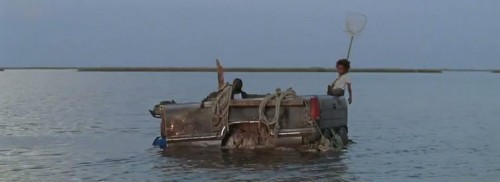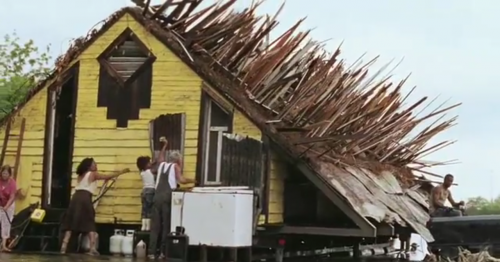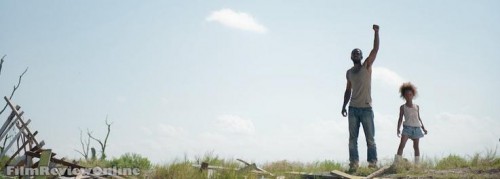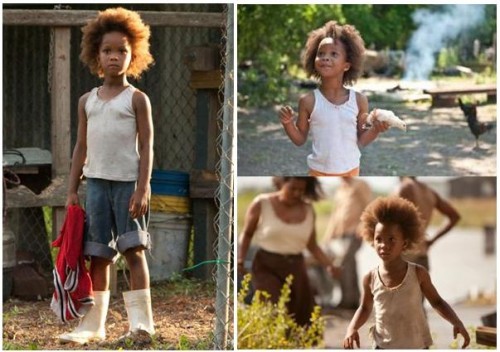Cross-posted at Montclair SocioBlog.
The crucial moment in “Beasts of the Southern Wild,” for me at least, was the sight of Hushpuppy in a new purple dress. Hushpuppy, a seven-year-old girl is the central figure in the film, and up until that point we have seen her, dressed in the same clothes every day, living in The Bathtub, a bayou area south of a fantastical New Orleans-inspired city, on the unprotected side of the levee.**
Life in The Bathtub is harsh. The people there (“misfits, drunks and swamp-dwellers” — Washington Post) live in shacks cobbled together from scrap metal and wood. They fish from boats that are similarly improvised. They scavenge. The children’s education comes from the idiosyncratic stories of one woman.
They are wild people living among wild things, unconstrained by laws or walls, reliant on ancient prophecies and herbal cures, at home with the water that may overwhelm them at any moment. — New York Review

 After a Katrina-like flood, the authorities force the evacuation of The Bathtub. Hushpuppy and the others are housed in a shelter – a large, brightly-lit room (a high school gym?) – and given new clothes. This is when we see Hushpuppy in her new purple dress heading out the door, presumably to a real school.
After a Katrina-like flood, the authorities force the evacuation of The Bathtub. Hushpuppy and the others are housed in a shelter – a large, brightly-lit room (a high school gym?) – and given new clothes. This is when we see Hushpuppy in her new purple dress heading out the door, presumably to a real school.
No, no, no, I thought. This is all wrong. This is not her. She belongs back in The Bathtub, for despite its rough conditions, the people there are a real and caring community. Her father loves her and prepares her for life there. The people there all love her and care for her, as they care, as best they can, for one another.
That was the voice of cultural relativism telling me to look at a society on its own terms, with understanding and sympathy.
At the same time, though, the voice of ethnocentrism was whispering in my other ear. This is America, it said. These conditions are the things you deplore and want to improve — lack of decent health care, education, clothing, shelter, and basic safety. (In an early scene, Hushpuppy tries to light her stove with a blowtorch, nearly incinerating her shack and herself.) It’s wrong that people in America live like this.
It was not much of a contest. Cultural relativism won.
In turning the audience into cultural relativists, the movie plays on old themes in American culture. We’ve always had our suspicions of civilization and refinement, and we’ve had a romantic attachment to the unrefined and rugged. In “Beasts,” the shelter — sterile, impersonal, and bureaucratic — is contrasted with The Bathtub — rough-hewn, but an authentic community nonetheless.
Then there is Hushpuppy. I’ve commented before (here, for example) that children in American films are often wiser, more resourceful, and more honest than the adults, especially those who would try to change them. Add Hushpuppy to the list.*
In the end, the audience seemed relieved when she and the others make their escape. We don’t want Huck to be civilized by Aunt Sally. And we do want Hushpuppy to light out for the territory of The Bathtub.

———————
* I should add that much of the credit for convincing the audience goes to the unforgettable six-year-old actress who plays Hushpuppy.
** Images borrowed from dirty-mag, allmoviephoto, thevisualvamp, filmreviewonline, boscosgrindhouse, and tampabaytimes.


Comments 21
Waugh — October 3, 2012
Yeah, save all that money we waste on the poor. Let them get sick and die without the medical help a few miles away...especially if they are poc.
Cook — October 3, 2012
I recommend checking out bell hook's commentary on Beasts of the Southern Wild: http://newblackman.blogspot.com/2012/09/bell-hooks-no-love-in-wild.html
Yrro Simyarin — October 3, 2012
Do the two need to be in conflict? You can't "rescue" people. You can provide them opportunities, but they have the right to decide whether they want to take them. Anything else is patronizing.
It's everyone's right to believe that their way is best.. that includes our right to say that a school and good clothes and moving out of the swamp is best. But anyone living there is completely within their rights to disagree with us. Celebrating that freedom isn't wrong, even if the freedom means making personal choices you don't agree with.
Andrew S — October 3, 2012
This was a great movie.
The white people rescued the savage of north america, did they not? (yes, that is sarcastic).
Just because a people live different from another people, perhaps polar opposite, does not make it wrong, bad or needing of change.
Let people live how they want to live. If it causes pain or suffering among others, then that should be dealt with, but people who choose to live in the bathtub or equal places, should be allowed to do just that. Anyone who wants to leave is welcome, but force isn't.
Anna — October 3, 2012
I've read so many conflicting reviews about this movie and really look forward to seeing it. Without having seen it, I can't really comment substantially, but I'm taken aback by the suggestion that a community of "misfits, drunks, and swamp-dwellers" can be real and caring. Emphasis on the drunks, as the other descriptions have neutral connotations. (Actually I'm drawn to the misfits part, unless it's used as a euphimism for something more sinister.) The use of "real" here is ambiguous, but in any case, a community largely made up of drunks indicates the breakdown of a community; a malfunctioning community, which is not a "real" community from my perspective. It can also not be caring (and this is not a judgment on the individuals' characters, which may be good-hearted and well-meaning for all I know); a large presence of alcohol abuse ravages a small community. I'm very weary of cultural relativism in general, although in those contexts when I believe it is appropriate, I subscribe to it wholeheartedly. In this context (and again, I have not seen the film, just read a lot about it, so I might be proved wrong) I'm troubled that cultural relativism could be seen as applicable, unless you completely romanticize the living conditions and behaviors that are depicted.
Interrobang — October 4, 2012
It's hardly "ethnocentrism" to want basic human rights (nutritious food, decent clothing, clean water, safe housing, education, and competent adult guidance) for a child.
I'd say equating all of modern American society with a sterile high school gym is doing it a disservice as well, kind of a negative romanticisation, if you will. (Is not modern western culture just as "authentic" as its nonconformant outliers?) There are plenty of opportunities for genuine community, improvisation, and the propagation of specific values *without* shorting a child on clothing, food, housing, and literacy.
Tusconian — October 4, 2012
I don't know. Coming from someone like the author, I feel like this is less about cultural relativism, and more about romanticizing poverty (as long as it's happening to an "other"). Saying that a young, poor black girl "belongs" in The Bathtub instead of in conventional education has very, very unfortunate implications when coming from an older man involved in academia who is almost certainly at least comfortably middle class, and as far as I can gather, white. Especially when "where she belongs" is not just culturally different, but apparently dangerous and abusive. Treating nonwhite people, especially children, as if they are only authentic if they are segregated into poor living conditions to practice their adorable, mystical cultures isn't striving for awareness of cultural relativism. It's making sure "those people" exist to be studied, to be stared at, the be talked about, to be pitied from afar, but NEVER get into "our" mainstream society to rub shoulders with "us" (I feel weird using "us" because I'm not even included in "us," but the "us" that Livingston would be a part of) and certainly not take up "our" resources, or educated "us" in "our" circles of education. This allows those in higher academic circles to "appreciate" their culture, but never be faced with having to share with them or be told that their ideas are wrong.
And similar to what Interrobang said; modern American society is not a sterile high school gym where all traces of culture have been stripped. This idea that America is synonymous with "cultural black hole" is an ignorant myth perpetuated by jaded suburban teenagers and stuffy intellectuals alike, who romanticize other cultures, any other cultures, because they haven't bothered to explore their own cultures outside of McDonald's and Bud Light. If you keep dreaming about how much more superior other cultures, ANY other cultures, are to your own, you'll miss the learning experiences right in front of you. This does not have to mean "modern America is superior to the bathtub," but it does mean that one has to stop pretending that modern Fantasy New Orleans (or real New Orleans) is a cultural wasteland.
barbara — October 4, 2012
From bell hooks' review, which I am so glad I read:
"...Sorrow
for all the lost traumatized children, but especially abused and abandoned
[black] children..." I have not seen the movie, but from reading the original post and then the comments here, I was getting angry with those who spoke from a position of "cultural relativism," when what is being discussed is NOT a group of adults who have CHOSEN to withdraw from society, or to create a new, functioning society and culture, but a CHILD with no ability to make such choices, merely at the mercy of the behaviors, chosen and otherwise, of those around her. Neglect, abandonment, starvation, violence, parental alcohol abuse, verbal abuse of children, while not a single person in her "community"protects her? None of these should be portrayed or excused as the "cultural choices" of a child. Please don't equate functioning societies and parenting styles that are different from our own and still deserving of respect with dysfunction and abuse.The one part of hooks' review I would disagree with is her reaction to the child's relationship with nature; in a lonely, abusive childhood, nature may provide a source of wonder, joy, beauty, comfort (as children often find with animals) and awe, which includes fear: a sense of the transcendent. I would not take such a thing away from a child--or adult--who had little else in their lives. And showing children connected in a "special" way to nature is not a film theme limited to black children (although today this racialized version is probably more common); it is a common theme in Western literature, religion, and art: "And a child shall lead them," because we assume, since William Blake, that children have a connection to the transcendent that is lost as they age. That Nature is presented in the movie as both comfort AND tremendous danger seems to symbolize a child's relationship with SOMETHING transcendent: Gods are both comforting and scary, beautiful and terrible, and so is Nature. But hooks is right that while we often equate children with "the primitive," Western culture also equates "the primitive" with blackness. Black=primitive=childlike=wise (but not educated)=less civilized=dangerous=scary...Geez. My head is spinning.
forsythia — October 4, 2012
This reminds me of family stories of my rather tomboyish grandmother. She fell ill, was taken to a hospital, and then handed off to a "foster home" that her parents didn't know about and couldn't get to. Grandma hated wearing dresses and being forced to be girly and lady like and go to school every day, and actually ran away and found her way home to her garrolous mixed-race clan and 11 brothers and sisters (some of whom also had children and lived with her or nearby).
Very hard to not land on both sides of that one - on one hand, she was neglected and fell ill without proper care. On the other, the hospital had no right to take her from her family.
Rayuela — October 4, 2012
Wow, SocImages, when you miss you really miss
anon — October 4, 2012
Could anyone explain what this means? I'm not being snide-- I really just don't understand the author's claim.
Cammycommando — February 16, 2013
I found the whole location of The Bathtub to be insular and fuled by paranoia, like so many "poor but tight-knit" settings. It was an uncomfortable feeling. And the idea presented here that no one would "love and care for her" outside it is disturbing. The same people are present; only the location has changed. And the idea of "ethnocentrism" here is horribly misused--or did you miss all the white people in the same situation? You're hyperfocusing on the main character's blackness when it had nothing to do with the film.
Renee — December 23, 2013
What do you think about Charter Schools then? My dad a NYC public school teacher (who's a good and bad teacher) says that Charter schools are just trying to whitify (word choice?) Black and Latino kids. Tell me what you think!! Is that ethnocentrism? Then again if you go to these schools you'll have an easier life. So this topic is back and forth in my head.
kadee — September 10, 2018
this sucks